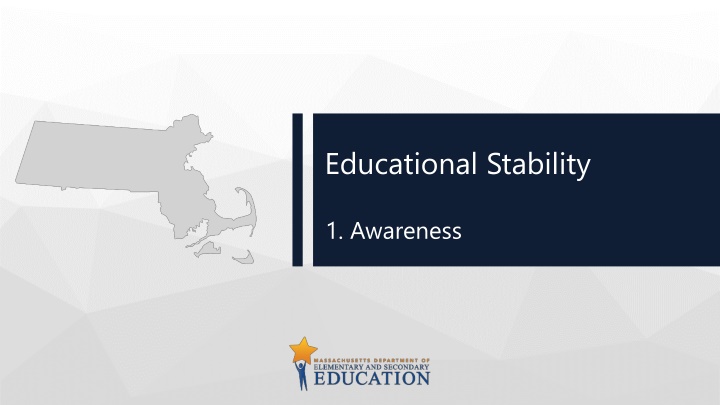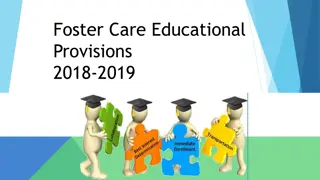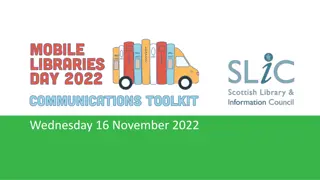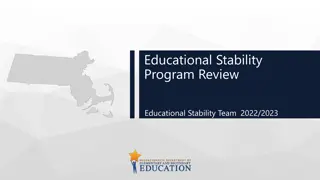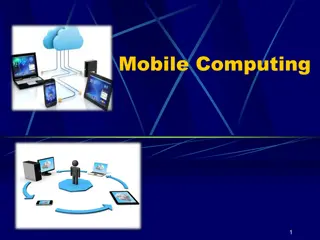Educational Stability and Rights for Highly Mobile Students
Welcome to the Educational Stability Training Series focusing on ensuring unique educational rights for highly mobile students such as military-connected, foster care, homeless, and migrant students. Learn about the legal acts in place and the importance of educational stability for these students who face barriers in accessing consistent education due to high mobility. Explore the specific definitions of highly mobile students and the initiatives taken by the Massachusetts Department of Elementary and Secondary Education to support their academic success.
Download Presentation

Please find below an Image/Link to download the presentation.
The content on the website is provided AS IS for your information and personal use only. It may not be sold, licensed, or shared on other websites without obtaining consent from the author.If you encounter any issues during the download, it is possible that the publisher has removed the file from their server.
You are allowed to download the files provided on this website for personal or commercial use, subject to the condition that they are used lawfully. All files are the property of their respective owners.
The content on the website is provided AS IS for your information and personal use only. It may not be sold, licensed, or shared on other websites without obtaining consent from the author.
E N D
Presentation Transcript
Educational Stability 1. Awareness
Educational Training Series Welcome to the Educational Stability Training Series! All children have a right to a public education. Some children experience barriers to accessing that education as a result of always being on the move or having high mobility. This module focuses on the awareness of the growing number of highly mobile students. 2 Massachusetts Department of Elementary and Secondary Education
The Why and the Who of it. Ensure unique educational rights for highly mobile students Every Student Succeeds Act of 2015 Massachusetts Valor Act of 2012 Military Connected Students Foster Care Students Homeless Students Migrant Students 3 Massachusetts Department of Elementary and Secondary Education
Legal Massachusetts Valor Act of 2012 Every Student Succeeds Act of 2015 Extends specific educational rights to these highly mobile students to ensure educational stability and their opportunity to succeed in school. Establishes participation in the Military Interstate Children's Compact Commission Ensuring assistance with transitions for timely enrollment, placement, eligibility, on-time graduation, and attendance. 4 Massachusetts Department of Elementary and Secondary Education
Highly Mobile Students Students who are in 24-hour out-of-home care, away from their parent(s)/legal guardian(s) and for whom DCF has care and placement responsibilities. = Foster Care Students who lack fixed regular and adequate nighttime residence including those who are sharing the housing of others due to economic hardship, loss of housing or similar reason. = Homeless Students or students parent(s)/guardian(s) who are a migratory agricultural worker, fisher, or food/fish processor, are under 21, have not completed high school, and have moved across district lines within the preceding 36 months. = Migrant Students whose parent/guardian is an active member of the uniform services, or has been medically discharged, retired, or died in active duty within the past year. = Military Please see module 2. Identification for detailed definitions. 5 Massachusetts Department of Elementary and Secondary Education
1 Why Educational Stability? 2 Poverty, Mobility, and Trauma 3 What the Data Shows? Content 4 Focus on Educational Stability 5 Contact Information & Resources
1 Why Educational Stability?
Why Educational Stability Going to school is a significant part of a child's life. Network of supports. New skills are learned. Friends are made. Breakfast and lunch served. Warm and dry during the winter. Consistency = Security and Safety. Medical, dental and mental health services. Massachusetts Department of Elementary and Secondary Education
What Happens ? All this can be lost when school is disrupted! . 9 Massachusetts Department of Elementary and Secondary Education
Causes and Results of Educational Instability Whether the disruption is caused by a parent following a crop for work; deployment to serve and protect our country; abuse or neglect of the child; or loss of a home, the effects are the same! Changing schools even once can take a student with an otherwise stable life four to six months to adjust to a new building, new classmates, and new teachers. For students that move and change schools frequently, the impact can be detrimental in many ways. One of the biggest ways: student disengagement! Reducing school changes, referred to in this series as educational stability, can make all the difference. 10 Massachusetts Department of Elementary and Secondary Education
2 Poverty, Mobility, Trauma
High Mobility does not happen overnight... Highly mobile students encounter many obstacles that have a tremendous impact on their day to day lives. Rarely will one event be the cause for their situation. More cumulation or combination of factors that will disrupt their education and hinder their ability to meet their potential as students. These experiences include: Racism Poor education Generational poverty Poor health/health crisis Substance abuse Cultural/language barriers Abuse/neglect Lack of affordable housing Low wages Debt Mental illness Domestic violence Immigration Multiple placements High rent + evictions Lost job/cut in hours Utility arrearages Medical bills CORI/SORI checks Exploitation Multiple deployments 12 Massachusetts Department of Elementary and Secondary Education
Poverty and Racism The long history of racism in Massachusetts has resulted in Redlining Housing/rental discrimination Evictions Poor education Wage gaps Health disparities Over representation in child welfare and juvenile justice and numerous other inequities. 13 Massachusetts Department of Elementary and Secondary Education
Impact of High Mobility This journey often includes: Food insecurity; Lack of medical, dental, and mental health services; Loss of connection to family, friends, community; and Trauma caused by loss or change. While some highly mobile students are unaccompanied (also known as out-of-school youth [OSY], see 12. Unaccompanied youth) many are still with family members or friends; all of whom are impacted too. Parents, siblings, and other family members will show signs of stress and even trauma. 14 Massachusetts Department of Elementary and Secondary Education
Who is Impacted by High Mobility? It can be a form of secondary trauma for the classroom. Students coming and going can disrupt learning even for the students who are stable. High mobility also impacts the teacher, classmates and others in the school. 15 Massachusetts Department of Elementary and Secondary Education
Impact of Highly Mobile Classmates ask, ... Teachers say,...and ask... "I've been worried about her" "Is she going to be ok? Is she safe?" "Could that happen to me?" This Photo This Photo by Unknown author is licensed under CC BY. CC BY 16 Massachusetts Department of Elementary and Secondary Education
The Consequences of High Mobility... Poor attendance Inability to focus and learn Educational gaps Social isolation Behavior and health related problems Low proficiency rates High dropout rates Low graduation rates More poverty 17 Massachusetts Department of Elementary and Secondary Education
HOPE This short clip shows the impact of these issues that too many of our students' experience. It also highlights the resiliency and possibilities. Tuba player finds harmony after homelessness 18 Massachusetts Department of Elementary and Secondary Education
3 What the Data Shows?
How Many Students in Massachusetts for 2018/19 School Year? 222 Military 6661 4 20 Migrant 91 351 11 101 261 Foster Care 7363 34 685 Homeless 22502 Toddler Preschool Kindergarten to 12 Ungraded OSY/UY 63 1408 20 Massachusetts Department of Elementary and Secondary Education
Where are the Homeless Students Sleeping? 206 = 1% 7,502 = 30% Shelters Motels Doubled Up Unsheltered Includes 1,408 Unaccompanied Youth 24,658 15,330 = 62% 1,620 = 7% 21 Massachusetts Department of Elementary and Secondary Education
Yearly Outlook for These Groups There is some overlap among these subgroups of students but it is safe to say that there are over 35,000 highly mobile students in Massachusetts each year. 22 Massachusetts Department of Elementary and Secondary Education
Impact of Mobility What the data points tell us about the impact of mobility: Lower proficiency rates. Higher rates of chronic absenteeism. Lower graduation rates. Lower rates of attending and completing high education. Higher dropout rate. 23 Massachusetts Department of Elementary and Secondary Education
4 Focus on Educational Stability
What Results When the Focus is on Educational Stability? Educational stability can: oImprove attendance oPromote steady academic progress oProvide continuity in peer and adult relationships oPromote on-time graduation from high school. Educational stability aims to mitigate the consequences of high mobility. 25 Massachusetts Department of Elementary and Secondary Education
5 Contact Information & Resources
Resources District and Area Office contacts District liaisons and POCs o Current list of homeless liaisons and local foster care POCs Updated by the district s Directory Administrator o Please verify your contact information DCF Contacts oDCF Area Directors (serving as local POCs) Network of Regional Liaisons o Carol Baez, Worcester Public schools o Jacob Hansen, Framingham Public Schools o Julie Mador, New Bedford Public Schools o Stacy Parsons, North Adams 508-799-3652 508-782-6894 508-997-4511 x3424 413-776-1677 27 Massachusetts Department of Elementary and Secondary Education
Resources DESE/DCF Educational Stability Team DESE Education Stability Website: http://www.doe.mass.edu/sfs/edstability.html Technical Assistance: Problem Resolution Services, 781-338-3700 Staff: Christine Cowen, Migrant Education, Military Connected Students 781-338-6301 Christine.H.Cowen@mass.gov Kristen McKinnon, Foster Care Point of Contact 781-338-6306 Kristen.A.McKinnon@mass.gov Jim Morrison, DCF Point of Contact 617-748-2340 James.J.Morrison@MassMail.State.MA.US Sarah Slautterback, State Coordinator, Homeless Education 781-338-6330 Sarah.E.Slautterback@mass.gov 28 Massachusetts Department of Elementary and Secondary Education
THANK YOU Educational Stability, Office of Student and Family Support 781.338.3010 achievement@doe.mass.edu https://www.doe.mass.edu/sfs/edstability.html
